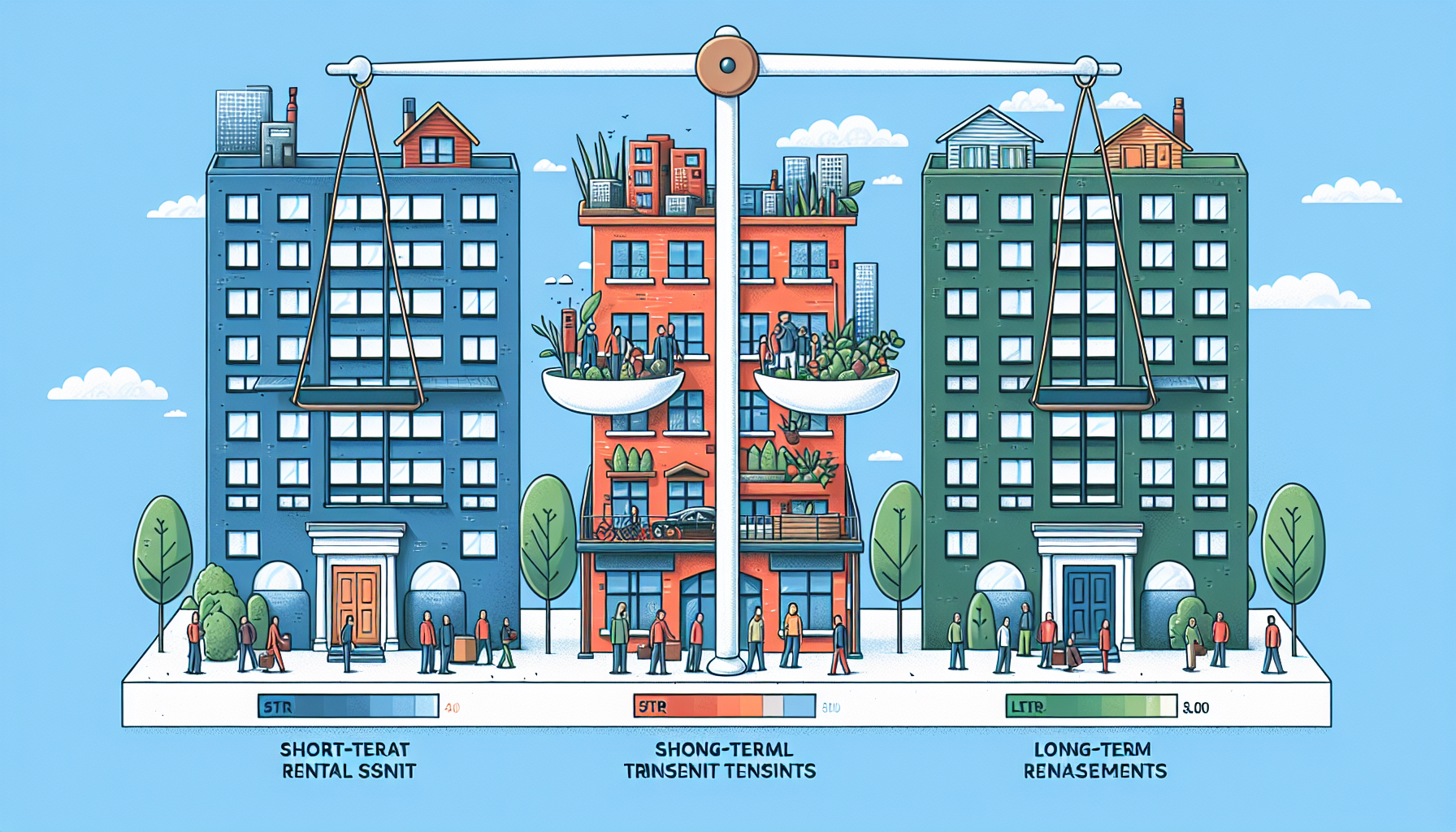In real estate, STR stands for ‘Short Term Rental,’ which refers to properties rented out for periods usually less than 30 days. This type of rental is especially popular among vacationers and business travelers, offering flexibility and potentially high returns for property investors. By understanding what STR means in real estate, enthusiasts and investors can navigate this dynamic segment of the housing market to uncover unique investment opportunities.
Key Takeaways
- Short-term rental properties (STRs) are housing units rented out for usually less than 30 days and are a growing market segment, but they are heavily influenced by local regulations and require owners to familiarize themselves with laws and permitting requirements.
- STRs hold the potential for higher income compared to long-term rentals (LTRs) due to factors like seasonality and market trends but demand more active management and preparation for high tenant turnover and periods of vacancy.
- Successful STR investing involves thorough market research, understanding the local legal landscape, adopting strategic pricing, and providing exceptional guest experiences to maintain high occupancy and improve profitability.
What Does STR Mean in Real Estate

Within the short-term rental (STR) segment of real estate, STR properties are equipped homes leased for usually no more than 30 days. This is in contrast to long-term rentals that engage tenants for extended durations. Owners of these short-term rental properties have the opportunity to enter a market aimed at accommodating tourists, individuals traveling for business, and temporary visitors looking for vacation rentals. It’s imperative that those interested in becoming property owners within this sector understand how local laws can greatly influence both the functionality and permissibility of running an STR property due to varying regulations governing the rental market.
STR Characteristics
The STR market is characterized by a wide array of property types, including apartments, condos, and vacation homes that appeal to various guest tastes and the requirements of the market. The sector’s attraction is enhanced by this variety. For example, as ‘slow travel’ becomes more popular with tourists looking for authentic local experiences that are also sustainable, a specific segment has emerged within the STR properties catering to these travelers’ preferences.
Platforms for STR Listings
Platforms such as Airbnb, VRBO, and HomeAway have transformed the short-term rental (STR) market by providing hosts with a user-friendly platform to list their properties, handle reservations, process payments, and communicate with guests. These platforms have been instrumental in simplifying access for STR property owners to connect with prospective guests while simultaneously contributing significantly to the expansion of the STR industry.
To this transformation, online reviews left on these services are critical in driving the performance of each property. This reality underscores why guest satisfaction has become a top concern for those owning STR properties.
Comparing STR and LTR Investments

Investing in short-term rental (STR) properties has the potential to be profitable, yet it’s important to discern how these investments stack up against long-term rental (LTR) opportunities. Key factors that distinguish an STR investment from its LTR counterpart include possible income levels, frequency of tenant turnover, and the demands of overseeing the property. A thorough analysis is vital for a complete grasp of what owning an STR investment property entails.
Income Potential
Properties operating under short-term rental agreements typically generate more substantial revenues than their long-term rental counterparts, with the potential for earnings to reach double or even 2.3 times that of similar LTR units when maintaining an occupancy rate of around 80%. This revenue is subject to variations stemming from seasonal changes and shifting market conditions that could influence mortgage payment levels.
It’s crucial to remain well-informed on current market trends as these fluctuations highlight the need for adaptable pricing strategies in order to optimize returns from STR properties.
Tenant Turnover
The frequency with which tenants come and go is a major distinction between STRs (Short-Term Rentals) and LTRs (Long-Term Rentals), largely because of the short-term nature of these agreements. This results in the need for continuous promotion and efforts to re-rent properties. Seasonal changes can cause significant fluctuations in demand for STRs, leading to variations in tenant turnover as well as inconsistencies in rental income flow. Investors focusing on short-term rentals must thus ensure they have adequate financial resources to cover potential gaps when their properties are unoccupied.
Management Requirements
Operating a short-term rental property Entails greater owner engagement compared to overseeing a long-term rental, given the need to oversee reservations and guarantee that the property is prepared for guests. Conversely, in the case of long-term rentals (LTRs), landlords usually face reduced operational expenses as tenants tend to take on responsibilities such as utilities and minor maintenance tasks.
Legal and Regulatory Considerations for STR Investors

Before embarking on investments in Short-Term Rentals (STR), it is crucial for potential real estate investors to fully grasp the legal and regulatory factors that may affect their investment strategies. This includes a thorough understanding of local zoning and permit regulations, tax responsibilities, as well as the specific insurance coverage required.
To Explore these areas, we will break down each component so those looking into real estate investing are thoroughly prepared for what’s involved with STR investments.
Zoning and Permitting
The requirements for zoning and permits related to Short-Term Rentals (STRs) can differ significantly from one city to another. Certain cities may enforce total prohibitions on STRs, while others might require an intricate system of permissions. Investors in STRs must make sure they abide by all local regulations concerning:
- Taxation
- Health standards
- Safety measures
- Licensing
- Permit acquisition
While dealing with these rules may be complex, resources are frequently available on the websites of local governments that assist individuals through the process, particularly when it comes to securing a business license.
Tax Obligations
Investment in Short-Term Rentals (STRs) comes with a series of tax responsibilities, such as:
- Transient occupancy taxes—also known as hotel or occupancy taxes—which guests are required to pay when their stays are brief.
- Sales taxes that might be levied on the rental income generated from STR properties, contingent upon the regulations set by local authorities.
- Income taxes on the profits made from renting out these properties. This is after deducting permissible expenses and must be duly declared and remitted.
Insurance and Liability
Given the frequent tenant turnover inherent in STR properties, there are distinct risks that may not be covered by typical homeowner or landlord insurance policies. It is essential for property owners of STRs to investigate specialized insurance plans to secure sufficient coverage against potential hazards such as liability claims and damage to their property.
Steps to Investing in STR Properties

Eager to dive into your short-term rental (STR) investment? Follow this detailed roadmap to successfully traverse the path ahead.
- Gauge your financial capacity
- Analyze the market thoroughly
- Examine local regulations
- Project potential costs
- Employ calculative tools for return on investment
Each step is a critical component of the overall STR investment strategy.
Market Research
Embarking on a successful STR investment begins with an in-depth market analysis. It’s vital to grasp the unique characteristics of the local market, including tourism patterns, economic health, and competitive landscape. Tools like Mashvisor’s Market Finder offer crucial insights into STR investments by delivering analytics that include projections for earnings, cash flow, cap rate, and occupancy rates via an Airbnb calculator.
Property Selection
In your real estate investment strategy focusing on short-term rental (STR) investments, the subsequent step is identifying an appropriate rental property. It’s essential to assess both the fair market value of a potential investment and its capacity for yielding profits. Conducting a detailed analysis of the rental property will enable you to determine if it aligns with your objectives for STR investment.
Financing Options
When you’ve pinpointed a property, the next step is to look into financing alternatives. You may consider traditional lending avenues or opt for private investors. The ability to secure financing for short-term rental (STR) properties can be influenced by various elements such as the net operating income of the property, demand within the rental market, overall property appraisals, and the necessity for a substantial initial down payment.
STR Property Management Best Practices

Proper management of STR properties is key to increasing their attractiveness and financial success. Essential elements for the fruitful handling of an STR property include:
- Upholding stringent cleanliness protocols
- Consistent upkeep and repairs
- Streamlined reservation processes
- Achieving elevated levels of occupancy
Guest Experience
In the STR (Short-Term Rental) market, delivering an outstanding guest experience reigns supreme. When guests have a remarkable stay, it often translates into top-notch reviews on sites such as Airbnb and VRBO. This heightened level of satisfaction can increase the attractiveness and prominence of your listing. To achieve this, hosts should focus on providing premium amenities, distinctive furnishings, and swiftly addressing any questions or concerns from guests.
Pricing Strategies
Establishing the right price point is essential for maximizing your short-term rental (STR) property’s earnings. By implementing dynamic pricing strategies, which modify rates in response to various market factors including demand, seasonal trends, and local events, you can ensure that your revenue is optimized.
Property owners can leverage platforms like Mashvisor’s dynamic pricing tool to set prices that are competitive while also streamlining the reservation and payment processes effectively.
Marketing and Advertising
To ensure your STR property thrives with sustained high occupancy and revenue, it’s crucial to deploy robust marketing and advertising techniques. Consider these strategies for enhanced visibility.
- Showcasing your properties on renowned platforms such as Airbnb and VRBO
- Leveraging social media channels to highlight your property features
- Conducting pinpointed advertising drives designed to captivate the attention of the target audience
These approaches can greatly increase exposure for your listing, leading you to draw in an increased number of bookings.
The rising importance of advanced technologies like virtual tours and augmented reality cannot be understated in today’s STR market. These tools facilitate a dynamic pre-reservation experience that serves as essential components within modern marketing arsenals.
Future Trends and Opportunities in the STR Market
As the market for short-term rentals (STR) is set to maintain its upward growth path, keeping abreast of upcoming trends and potential prospects becomes crucial. The STR arena is in a state of flux with an uptick in consumer interest towards distinctive properties and eco-friendly offerings, along with a growing impact from technological advancements.
Technological Advancements
The STR market is experiencing a transformation due to the rise of technological innovations. Software dedicated to property management simplifies the running of short-term rental properties by bringing together various functions like managing reservations and maintaining the property under one system.
Incorporating cutting-edge technologies such as Artificial Intelligence, these advancements are enhancing guest experiences with personalization while also boosting operational efficiency in STR property management.
Niche Markets and Unique Properties
Are you in search of a distinctive investment option? Interest is surging for unconventional and exciting property types within the short-term rental (STR) market, like treehouses and eco-retreats. These specialized segments present thrilling chances for investors aiming to set their offerings apart and draw in a particular clientele within the real estate market.
Summary
Real estate investors have a treasure trove of prospects within the realm of STR investments. Grasping distinctive properties, handling legal and regulatory frameworks, managing assets proficiently, and keeping abreast of upcoming trends are all essential aspects to master in this vibrant sector. So, is your curiosity piqued to delve into the possibilities that STR investments hold?
Frequently Asked Questions
What is an STR in real estate?
In the real estate industry, a short-term rental (STR) refers to a property equipped with furnishings that is leased out for typically no more than 30 days at a time.
How does the income potential of STRs compare to LTRs?
Assuming an 80% occupancy rate, short-term rental (STR) properties frequently have the potential to generate income that is approximately two to 2.3 times greater than what long-term rental (LTR) properties can produce. This can vary due to changes in seasonality and market conditions.
What are the legal and regulatory considerations for STR investors?
For investors in short-term rentals, it is imperative to possess an in-depth knowledge of the local statutes and ordinances governing aspects such as zoning, permits, taxation duties, and mandatory insurance coverage. Grasping these legal frameworks and regulatory requirements is vital for the successful management and legal operation of short-term rental properties.
What are some best practices for managing STR properties?
For successful management of STR properties, it is crucial to put an emphasis on maintaining a high level of cleanliness, performing consistent maintenance, handling booking processes adeptly, and ensuring that occupancy rates remain elevated.
Achieving these goals can lead to the optimization of the property’s capabilities while also significantly enhancing guest contentment.
What are some emerging trends in the STR market?
In the short-term rental (STR) market, there is a noticeable uptick in consumer interest for distinctive lodgings such as treehouses and eco-friendly retreats. Concurrently, technological advancements are being embraced to enhance operational efficiency and elevate the overall experience for guests.


